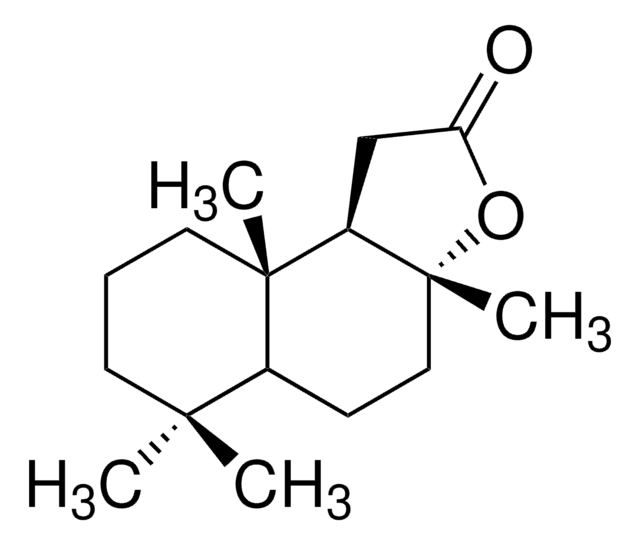W279714
Octanal
natural, ≥95%, FCC, FG
Synonim(y):
Aldehyde C8, Caprylic aldehyde, Octyl aldehyde
About This Item
Polecane produkty
klasa czystości
FG
Fragrance grade
Halal
Kosher
natural
Poziom jakości
agency
follows IFRA guidelines
meets purity specifications of JECFA
zgodność regionalna
EU Regulation 1223/2009
EU Regulation 1334/2008 & 178/2002
FCC
FDA 21 CFR 172.515
ciśnienie pary
2 mmHg ( 20 °C)
850 mmHg ( 25 °C)
Próba
≥95%
charakterystyka ekologicznej alternatywy
Less Hazardous Chemical Syntheses
Use of Renewable Feedstocks
Learn more about the Principles of Green Chemistry.
sustainability
Greener Alternative Product
współczynnik refrakcji
n20/D 1.421 (lit.)
tw
171 °C (lit.)
mp
12-15 °C (lit.)
gęstość
0.82 g/mL at 25 °C (lit.)
Zastosowanie
flavors and fragrances
Dokumentacja
see Safety & Documentation for available documents
alergen pokarmowy
no known allergens
alergen zapachowy
no known allergens
Organoleptyczne
fatty; green; orange; waxy; citrus
ciąg SMILES
[H]C(=O)CCCCCCC
InChI
1S/C8H16O/c1-2-3-4-5-6-7-8-9/h8H,2-7H2,1H3
Klucz InChI
NUJGJRNETVAIRJ-UHFFFAOYSA-N
Szukasz podobnych produktów? Odwiedź Przewodnik dotyczący porównywania produktów
Powiązane kategorie
Opis ogólny
Hasło ostrzegawcze
Warning
Zwroty wskazujące rodzaj zagrożenia
Zwroty wskazujące środki ostrożności
Klasyfikacja zagrożeń
Aquatic Chronic 3 - Eye Irrit. 2 - Flam. Liq. 3 - Skin Irrit. 2
Kod klasy składowania
3 - Flammable liquids
Klasa zagrożenia wodnego (WGK)
WGK 2
Temperatura zapłonu (°F)
125.6 °F - closed cup
Temperatura zapłonu (°C)
52 °C - closed cup
Środki ochrony indywidualnej
Eyeshields, Faceshields, Gloves, type ABEK (EN14387) respirator filter
Certyfikaty analizy (CoA)
Poszukaj Certyfikaty analizy (CoA), wpisując numer partii/serii produktów. Numery serii i partii można znaleźć na etykiecie produktu po słowach „seria” lub „partia”.
Masz już ten produkt?
Dokumenty związane z niedawno zakupionymi produktami zostały zamieszczone w Bibliotece dokumentów.
Klienci oglądali również te produkty
Nasz zespół naukowców ma doświadczenie we wszystkich obszarach badań, w tym w naukach przyrodniczych, materiałoznawstwie, syntezie chemicznej, chromatografii, analityce i wielu innych dziedzinach.
Skontaktuj się z zespołem ds. pomocy technicznej













